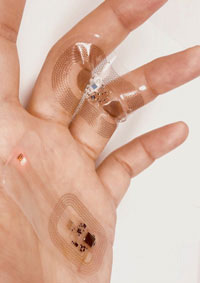Wireless sensors help NICU babies get more hugs
SQI’s John Rogers’ soft, wireless sensors out-perform current technology
A cross-disciplinary team co-led by SQI faculty member and Center for Bio-Inspired Electronics (CBIE) director John A. Rogers has tackled a problem for babies in NICU units by creating clinical-grade, wireless, soft sensors. The sensors were tested alongside the current wired versions and were shown to provide data with the same level of accuracy. The wireless sensors even provide additional data that may be clinically useful such as blood pressure and oxygen levels. The results have been published in the journal Science.
 It is important for doctors to monitor vital data like heart rate and respiration. But until now, doing so required that the tiny patients are surrounded by a “rats-nest” of wires — making parent or nurse interactions daunting and complicated. This is important because there is already a clear body of evidence that skin-to-skin interactions are beneficial for babies, especially “premies”. By removing the wires, and providing easier contact, the outcomes of these tiny patients can be improved.
It is important for doctors to monitor vital data like heart rate and respiration. But until now, doing so required that the tiny patients are surrounded by a “rats-nest” of wires — making parent or nurse interactions daunting and complicated. This is important because there is already a clear body of evidence that skin-to-skin interactions are beneficial for babies, especially “premies”. By removing the wires, and providing easier contact, the outcomes of these tiny patients can be improved.
The team has also designed the solution to help patients with fewer economic advantages. Thanks to the Bill and Melinda Gates Foundation, in April they will be rolling out systems in Zambia. The Northwestern research team included Dr. Amy Paller, Dr. Shuai (Steve) Xu, Dr. Aaron Hamvas and Dr. Debra Weese-Mayer from the Feinberg School of Medicine, and Dr. Yongguang Huang from the McCormick School of Engineering.
